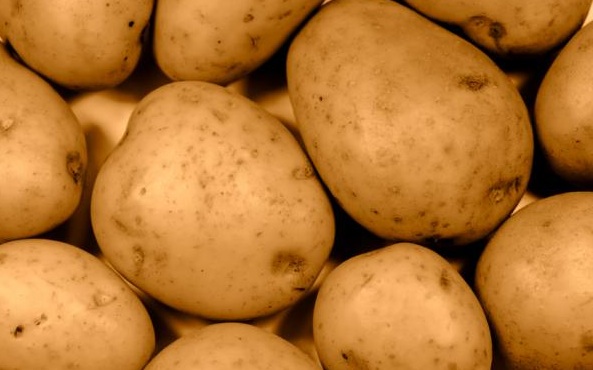
Features
Production
Research
Potato farmers work to attract McDonald’s
September 24, 2009 By The Canadian Press
 September
September
24, 2009, Kimberly, Idaho – From the fields of Idaho to tasting rooms in
suburban Chicago, potato farmers, researchers and industry representatives are
in the midst of an elusive hunt: finding a new spud for McDonald’s French
fries.
September
24, 2009, Kimberly, Idaho – From the fields of Idaho to tasting rooms in
suburban Chicago, potato farmers, researchers and industry representatives are
in the midst of an elusive hunt: finding a new spud for McDonald’s French
fries.
 |
|
A
decade has passed since the fast-food giant last added a new U.S. potato
variety to three others approved for its golden fries, something that both irks
and motivates potato researchers who hope their progeny will be next.
Because
McDonald’s buys more than 3.4 billion pounds of potatoes annually, it has the
power to dictate whether a variety sprouts or winds up in the less-lucrative
supermarket freezer’s crinklecut bin – or worse yet, banished to become dehydrated
taters.
“It’s
a card game where McDonald’s holds nine-tenths of the cards,” said Jeanne
Debons, the Potato Variety Management Institute’s director.
The
institute was established in 2005 by the Idaho, Oregon and Washington potato
commissions to handle licensing and royalties from new potatoes developed at
universities and federal research facilities in the three states.
An
unwritten ambition: to get new potato varieties looked at by McDonald’s.
The
company still relies on the Russet Burbank for many of its fries, even though
this 130-year-old variety takes an eternity to mature, gulps water and falls
victim to rots and other diseases, meaning farmers must douse it in chemicals.
Socially conscious investors want McDonald’s to help cut pesticides to protect
the environment and farm worker health.
Still,
coming up with a spud stud is no mean feat: One of the last varieties
McDonald’s tested, the Premier Russet, has a pedigree that on paper resembles
the lineage of a thoroughbred race horse, with ancestors like the buff-skinned
Penobscot of Maine. The company decided it was an also-ran.
“It
has a smaller starch cell,” Mitch Smith, McDonald’s agricultural products
director, recalls of tasters’ conclusions about the Premier. “You get a
smoother texture, it does affect the way it eats.”
Other
U.S. potato-growing regions are also on the case. In July, researchers and
industry reps meeting in Sturgeon Bay, Wisconsin, home of the U.S. Potato Gene Bank , discussed new sustainable varieties to help “McDonald’s to advertise that
potatoes they serve are produced with less chemical and water input,” said
Chuck Brown, of the U.S. Department of Agriculture.
To
be sure, McDonald’s has increased its use of other potato varieties in the last
decades.
Early-maturing,
Canadian-bred Shepody potatoes go into many of its fries sold in August,
September and October. But those potatoes don’t store well, so by November,
Ranger Russet fries hit the fast-food joints. And better-storing Umatilla
Russets – the last
U.S.
potato variety approved by McDonald's back in 1999 – fill the bellies of
consumers from late December until the end of February.
From
then on, Russet Burbanks, with robust storage qualities, consistent texture and
taste, remain Mickey D’s mainstay, though this variety brought West by
Massachusetts botanist Luther Burbank in 1875 is costly to produce.
Across
the U.S., the Russet Burbank has a declining market share, but is still no
small potatoes. In 2008, Idaho potato farmers planted 57 per cent of their
total acres with Russet Burbanks, while the variety accounted for 41 per cent
across the eight biggest potato-producing
states.
Allan
French, a globe-trotting J.R. Simplot manager who oversees potato varieties
that feed a sprawling fry-processing empire stretching from Idaho to China,
says finding a replacement has been elusive.
“We’re
always looking for the silver bullet to replace the Russet Burbank,” French
said.
Coming
up with a reliable new variety takes years. The Premier Russet emerged from the
breeder’s greenhouse in the early 1990s, but wasn’t released for commercial
growers until 2006. Along the way, it underwent
storage trials at facilities near the tiny farming town of Kimberly.
Here,
University of Idaho researchers stack experimental varieties in refrigerated
stalls, testing everything from sprout resistance to shrinkage. And in the test
kitchen next door, storage scientist Tina Brandt fries up new varieties, to see
how they stack up to Russet Burbanks, which tend to develop unsightly dark
splotches that crop up on fry ends.
“There
have been a lot of fantastic varieties that have come along over the years, but
for one reason or another – shrinkage in storage, disease resistance, texture –
they haven’t been adopted,” Brandt
laments.
At
the McDonald’s campus in Oak Brook, Illinois, perfume-wearing intruders are
shooed from tasting rooms, to prevent contamination of French fries samples
randomly pulled from restaurants around America for monthly scrutiny by
representatives of the company’s three main suppliers: J.R. Simplot Co. of
Boise, Canada’s McCain Foods Ltd., and Omaha-based Con-Agra Foods Inc.
These
days, however, taste, texture and golden-brown appearance aren’t everything.
In
March, three activist investor groups won an agreement from McDonald’s to
promote best practices to cut pesticide use by its American potato suppliers.
So
far, the groups say the company is doing a “great job” adhering to its
commitments.
McDonald’s
Smith says he’s satisfied growers are already working efficiently and sustainability,
largely because wasteful water or chemical practices dent their profits. But
finding new potato varieties to meet that goal – and that don’t hurt quality –
remains on the horizon.
Just
now, Smith said, McDonald’s is scrutinizing the Bannock Russet, a 10-year-old
potato variety bred originally in Idaho that isn’t as susceptible to disease as
Russet Burbanks.
“If
we can find a variety that does that, with less inputs, water or whatever,
that’s something we’re looking for,” Smith said. “To date, there are not a lot
of varieties that perform consistently enough.”
Print this page